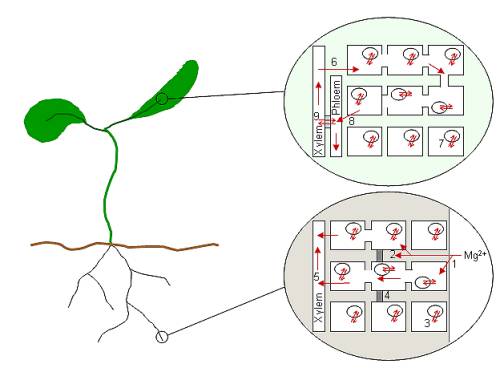
FAQ About Indoor Plant Nutrient Transport Mechanisms

What are the primary nutrient transport mechanisms in indoor plants?
Indoor plants primarily use two vascular tissues for nutrient transport: xylem and phloem. Xylem is responsible for the upward movement of water and dissolved minerals from the roots to the leaves, while phloem transports sugars and other organic nutrients produced during photosynthesis from the leaves to other parts of the plant.

How does xylem function in nutrient transport for indoor plants?
Xylem functions by transporting water and dissolved minerals from the roots to the stems and leaves through a process called transpiration. As water evaporates from the leaves, it creates a negative pressure that pulls more water into the plant through the roots, carrying essential minerals along with it.

What role does phloem play in nutrient transport?
Phloem transports organic nutrients, particularly sugars produced during photosynthesis, from the leaves to other parts of the plant. This process, known as translocation, helps distribute energy resources to growing parts such as roots, fruits, and seeds and supports overall plant growth.

Why is nutrient transport important for indoor plant health?
Nutrient transport is crucial for the growth and health of indoor plants as it ensures that essential minerals and nutrients reach various parts of the plant. Proper distribution of nutrients allows plants to perform vital functions like photosynthesis, respiration, and energy allocation for growth and development.

How can I improve nutrient absorption in my indoor plants?
Improving nutrient absorption can be done by ensuring the soil is well-aerated and properly watered. Use fertilizers designed for indoor plants, maintaining appropriate pH levels, and avoiding over-watering to prevent root rot. Additionally, ensuring adequate light and temperature will support the plant's metabolic processes.

What factors can affect nutrient transport in indoor plants?
Several factors can affect nutrient transport in indoor plants, including soil quality, watering habits, temperature, light, and humidity levels. Poor soil aeration, incorrect watering, and inappropriate temperature or light conditions can impair the plant's ability to absorb and transport necessary nutrients.

Can over-fertilizing harm indoor plants and their nutrient transport systems?
Yes, over-fertilizing can damage indoor plants by creating a toxic environment for roots, leading to nutrient imbalances and disruptions in nutrient transport. This can result in symptoms such as leaf burn, stunted growth, and even plant death if not addressed promptly.

How does water quality impact nutrient transport in indoor plants?
Water quality is critical for nutrient transport as it affects the plant's ability to absorb and use nutrients. Hard water can lead to mineral buildups in the soil, while soft water may lack necessary minerals. Use distilled or rainwater if local water is unsuitable for plant growth.

What signs indicate poor nutrient transport in indoor plants?
Signs of poor nutrient transport can include yellowing leaves, stunted growth, and poor flowering or fruiting. Additionally, nutrient deficiencies might show as specific symptoms, such as interveinal chlorosis for iron deficiency or curled leaf edges for potassium deficiency.

Are certain indoor plants more efficient at nutrient transport than others?
Yes, some indoor plants are better adapted to efficiently transport nutrients due to their physiological traits or natural habitat requirements. For instance, succulents have adapted to store water efficiently and thus are better at managing nutrient transport in arid conditions.

How do indoor plants adapt their nutrient transport mechanisms in low light conditions?
In low light conditions, indoor plants may slow their growth and nutrient uptake as photosynthesis rates decrease. They may also adapt by reallocating resources to optimize available light, which may involve changes in leaf orientation or size to capture more light.

Does temperature affect nutrient movement in indoor plants?
Temperature plays a significant role in nutrient movement because it influences plant metabolism and water evaporation rates. Extreme temperatures can slow down or even disrupt the transport processes, either by freezing water in the xylem or by accelerating evaporation to problematic levels.

How do I ensure balanced nutrient transport in my indoor plant setup?
To ensure balanced nutrient transport, maintain consistent watering schedules, use quality potting soil, and provide adequate lighting and temperature. Regularly check and adjust soil pH, and use fertilizers judiciously to provide necessary macro and micronutrients without causing imbalances.

What is the difference between macro and micronutrient transport in plants?
Macronutrients, such as nitrogen, phosphorus, and potassium, are needed in larger quantities and play significant roles in plant structure and energy transfer. Micronutrients, like iron, zinc, and manganese, are required in smaller amounts but are essential for biochemical processes and enzyme function. Both are transported through xylem and phloem but might have different pathways depending on their chemical nature.

Can changes in humidity levels affect nutrient transport in indoor plants?
Humidity levels can significantly impact nutrient transport because they affect the transpiration rate. High humidity can reduce transpiration, limiting water and nutrient uptake, while low humidity can increase water loss and potentially lead to nutrient imbalances if not managed properly.

How does root health influence nutrient transport in indoor plants?
Healthy roots are vital for effective nutrient transport as they absorb water and minerals from the soil. Root damage due to pests, disease, or overwatering can impair nutrient uptake, leading to deficiencies and reduced plant vitality. Maintaining healthy roots through proper care practices is essential.

What are some common misconceptions about nutrient transport in indoor plants?
A common misconception is that more frequent watering always improves nutrient uptake, whereas excessive watering can actually lead to root rot and decreased absorption. Another misconception is that all fertilizers work equally for every plant, whereas different plants may have varying nutrient requirements.

How do xylem and phloem work together in indoor plants?
Xylem and phloem work together to ensure a continuous flow of nutrients and water throughout the plant. While xylem transports water and minerals upwards, phloem distributes the photosynthetic products from leaves to other parts. This coordination supports all physiological activities in the plant.

How can I test for nutrient deficiencies affecting transport in indoor plants?
To test for nutrient deficiencies, observe the plant for specific symptoms like leaf discoloration or distorted growth, and conduct a soil test to identify pH and nutrient levels. Home test kits or professional soil analysis services can help determine which nutrients are lacking and require supplementation.
